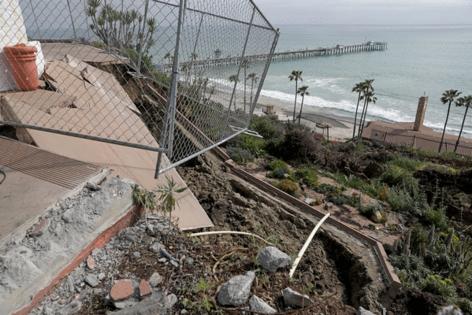Calif. state Sen. Blakespear says coastal railroad is at a climate crossroads. 'The data is clear and the message more urgent.'
Published in News & Features
A coordinated, multiagency effort is essential to save Southern California's coastal rail corridor from sea-level rise and erosion, state Sen. Catherine Blakespear warned last week.
"The data is clear and the message more urgent than ever that our coastline near the rail line is at critical risk of failure," said Blakespear, D-Encinitas, at a hearing held by the Subcommittee on LOSSAN Rail Corridor Resiliency that she chairs in Sacramento.
Seven different state and regional administrators updated the subcommittee Monday on the status of problem areas along the 351-mile-long Los Angeles-San Diego-San Luis Obispo rail corridor, focusing primarily on trouble spots in San Diego County and San Clemente in neighboring Orange County. The route is San Diego's only passenger and freight train connection to Los Angeles and the rest of the United States.
Sections of the railroad in Del Mar and San Clemente are especially vulnerable.
About 1.7 miles of the track in Del Mar follows the edge of a tall, fragile bluff 60 feet above the ocean. The San Diego Association of Governments, the regional planning agency, has been working for years on plans to reroute the tracks into a tunnel away from the bluff, but that won't happen until at least 2035.
In San Clemente, a seven-mile stretch of the track runs along the shrinking beach below crumbling bluffs.
"The rail is getting attacked from both sides," said San Clemente City Manager Andy Hall. Mother Nature has assaulted the tracks there from the west by scouring the sand from the beach, and from the east by weakening the steep bluff and unleashing landslides.
The Orange County Transportation Authority recently began considering long-term solutions for the seven miles of beachfront track there, including the possibility of a new inland route. However, the relocation there is uncertain and, if chosen, is decades in the future.
Any solution, even a quick one, is expensive. The Orange County Transporation Authority, working with Metrolink, spent $9.2 million on cleanup and construction of a catchment wall finished in March after a landslide at Mariposa Point in San Clemente.
In December 2023, the OCTA identified four new trouble spots that need protection from beach erosion and possible slope failures, said Darrell Johnson, the agency's chief executive officer.
...continued
©2024 The San Diego Union-Tribune. Visit sandiegouniontribune.com. Distributed by Tribune Content Agency, LLC.







Comments